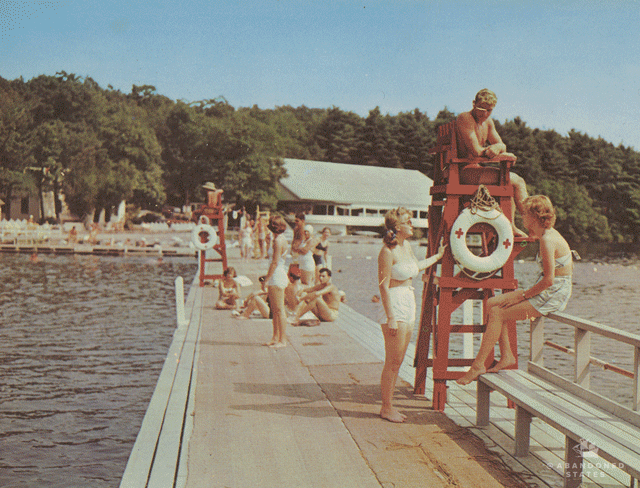I found the old matchbook lying on a desk, writes Pablo Maurer. It was buried under some papers, beside a thick, water-logged book frozen solid in the January chill. I ran my fingers down its spine and read the title: “How to Run A Successful Golf Course.”
The owner of the Penn Hills Resort in the Poconos probably hadn’t followed whatever advice the author had to offer. They boarded the place up years ago, and there’s a gaping hole in the roof of his old office. Muted greens and yellows, shag carpeting peek at me through a sheet of ice.
The matchbook, which looks to be from the 60s, is about half empty – whoever was sitting here when this place finally went under surely needed a smoke.
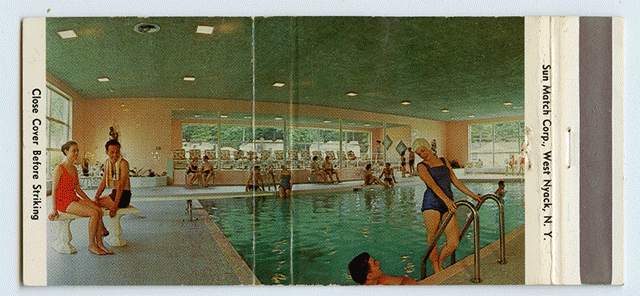
On the inside of the matchbook, some text: “Swim n’ Sun Indoor Swimming Pool at Penn Hills Lodge and Cottages. The Poconos’ Finest Modern Resort.” (Photograph by Pablo Iglesias Maurer, matchbook publisher unknown.)
Its cover is a reminder of better days. Swimmers are frolicking at the resort’s indoor pool, now a scene of trash, mangled deck chairs, a life preserver. I lock eyes with a huge bullfrog who didn’t make it out. He was entombed in the ice.
The matchbook no longer lines up with reality. I look down through the viewfinder of my camera and up again at the matchbook, aligning the two images the best I can. Up (snap) down (snap). It feels like I’m seeing this place in some sort of dystopian View-Master, each image on the wheel darker than the next.
Weeks later, I score a cache of old postcards from the Poconos and Catskills on eBay, the sort that end up in family albums, stuck in some box in the attic. “Our Honeymoon.” In idyllic scenes at Penn Hills, The Homowack Lodge, Grossinger’s, and a fourth resort in the Poconos which we aren’t identifying, vacation-goers and honeymooners frolic in the mountains.
They have a surreal quality. Ephemeral, disposable, they served only one purpose—to let someone know “I’m here. I’m thinking of you.” It feels a bit like social media does sometimes, where you’ll snap a photo of some vista, sometimes to bring those you care about a bit closer to you. And like social media, the postcards manage to be a little impersonal: “I didn’t quite care enough to write a letter.” It’s analog Foursquare, a non-digital check-in.
Over the past few years, I’ve gone back to the places in the postcards.
On Christmas Day a couple years back, I went into an abandoned bowling alley in the Catskills, stood up some pins and bowled a couple of frames. That signature sound—the pins caroming about—sounds a lot different in a place like that. There are echoes of the postcard, where a bear of a man stands at the shoe rental counter. No shoes now, no phone, no counter.
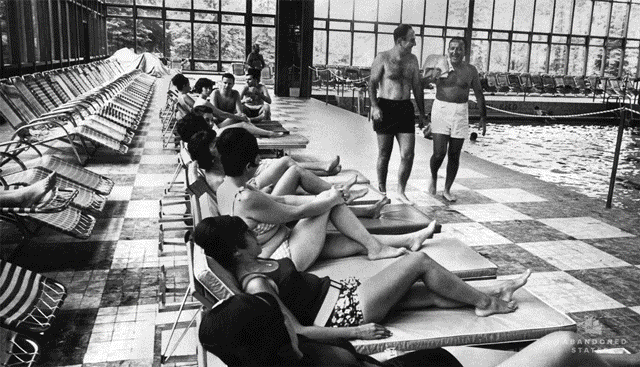
More of the indoor pool at Grossinger’s. The tiled floor was heated, the entire structure air conditioned. Above, beautiful mid-century “sputnik” chandeliers cast a glow on the swimmers below. Below the pool are exercise rooms, a gym, salon and a host of other amenities. The pool has sat vacant since the late 90’s and has fallen beyond repair. (Photo by Pablo Iglesias Maurer, historical photo published by Bill Bard Associates.)
Other times, the search is a bit more challenging.
I trudged through an old resort in the Poconos last year, just a few months after a fire burned half the place down. In the postcard, a couple poses in front of a gazebo. Now, it’s just a pit in the ground. Time is a sink hole.
Photos of abandonment tend to be a bit stylized, painting decay with a nostalgic brush. The postcards, too, have their own haze—the places were never as nice as they look. I often struggle to get the two images to line up, as well. But time blurs the difference, and brings everything into focus.
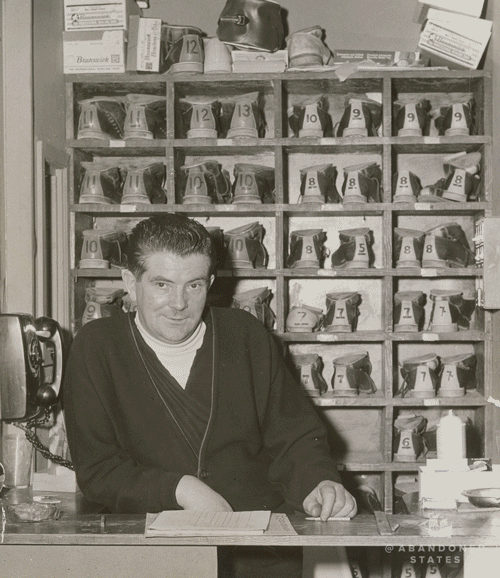
A lane attendant at the Homowack lodge in the Catskills. (Photograph by Pablo Iglesias Maurer, before image courtesy of the Catskills Institute at Brown University).
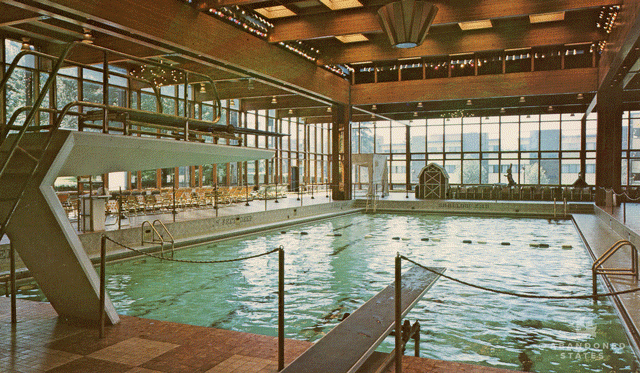
The indoor pool at Grossinger’s, which opened in 1958. Elizabeth Taylor attended the pool’s opening, and Florence Chadwick – the first woman to swim the English Channel in both directions – took the first dip in it. From Ross Padluck’s excellent “Lost Architecture of Paradise”: “…The new indoor pool at Grossinger’s was the zenith of the Catskills. Nothing quite like it had ever been built, and nothing ever would be again. It represented everything about the Catskills in the 1950s-style: extravagance, luxury, modernism and celebrity.” (Photograph by Pablo Iglesias Maurer, postcard published by Bill Bard Associates.)
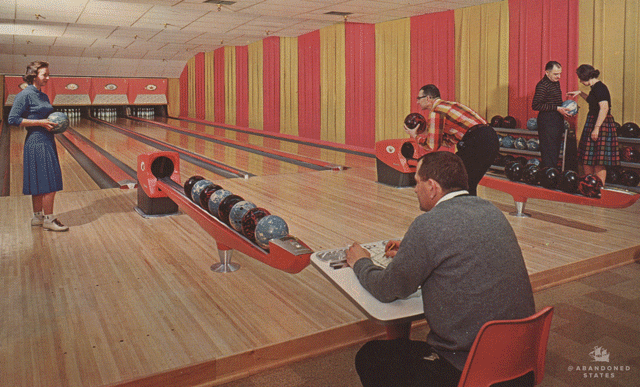
The Homowack Lodge now sits abandoned on the southern edge of the famed “Borscht Belt.” On its lower level, maybe the highlight of the place, a four-lane Brunswick bowling alley. It has seen better days. The resort closed in the mid-2000’s but lived on briefly, first as a Hasidic resort and lastly as the site of a summer camp—one which was forced to shut down after the NY Department of Environmental Conservation deemed it uninhabitable. (Photograph by Pablo Iglesias Maurer, postcard published by Bill Bard Associates)
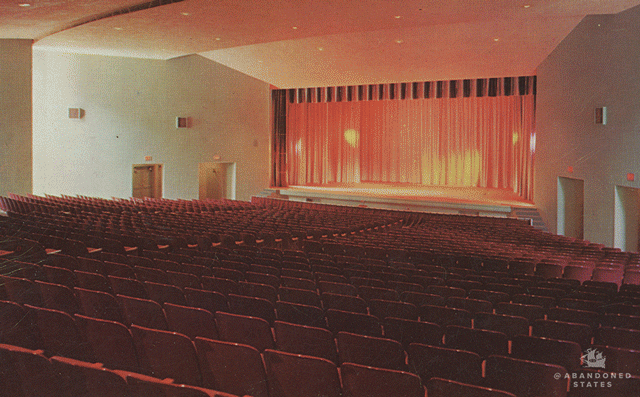
The caption on the back of this Pocono resort’s postcard touts this theater as the “resort world’s most modern showplace.” With a capacity of 1200, it remains splendorous even in disrepair. This postcard is also postmarked, and filled out. “Having a lovely weekend here. All pleasure – only exercise is rowing a boat and playing shuffleboard! Nice to be lady-like and not “rushing” about! We will see you soon.” (Photograph by Pablo Iglesias Maurer, postcard published by Kardmaster Brochures.
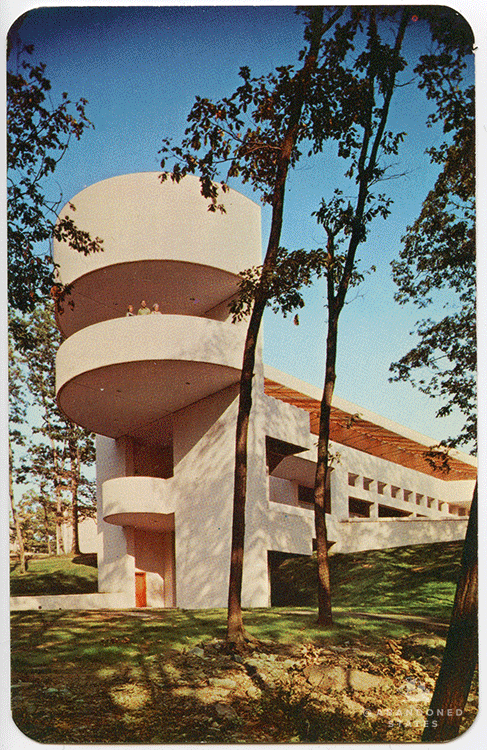
After a fire destroyed the main building at this resort in the Poconos, a replacement went up in the early 70’s. It is a truly striking sight, a modernist spaceship tucked away deep in the woods. (Photograph by Pablo Iglesias Maurer, postcard by Kardmasters)
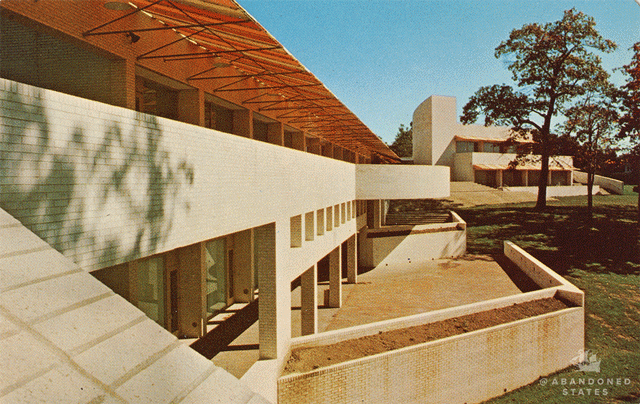
Looking down the side of that same 70’s structure. “Ultra-modern building houses the dining room, cocktail lounge, lobbies and offices.” (Photograph by Pablo Iglesias Maurer, poscard by Kardmaster Brochures)

A residential building at a Poconos resort sits in disrepair. On the back of the postcard: “Dear Bernie – Don’t think we forgot you – but we’re having such a grand time that post cards are a chore! This is the life & the place & the people are grand. We couldn’t be happier or have more fun. See you soon! Love, Lou & Shiela.” (Photograph by Pablo Iglesias Maurer, postcard published by Kardmaster)
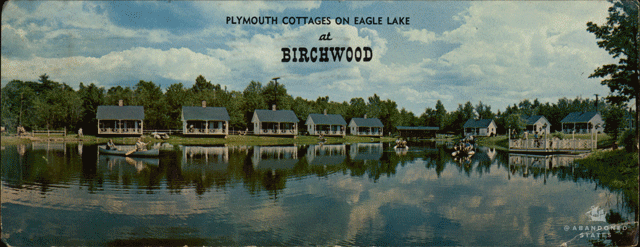
Postcard caption: “Birchwood is the only resort offering three swimming pool facilities, indoor pool, outdoor pool and lake with beach. Pictured here is beautiful Eagle Lake, at the foot of the Village Green. Here couples enjoy the white-sand beach, chaise lounges, bicycle and row boats, and fish off its shores … Six low-cost all-expense package plans include indoor swimming, airplane rides, movies, bowling, horseback riding, all winter sports and 40 other free activities!” More recently, the hangar at the resort’s airstrip served a different purpose: cop killer Eric Frein made the place his home during a weeks-long manhunt and was eventually apprehended just a stone’s throw from Eagle Lake. (Photograph by Pablo Iglesias Maurer, postcard published by Planned Color Post Cards)
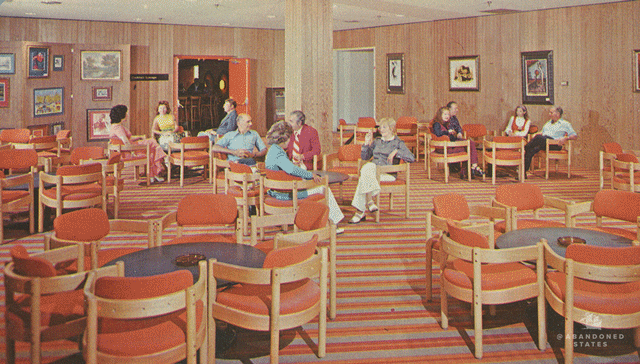
The cocktail lounge of a now-defunct resort in the Poconos. “Peaceful relaxation – healthful recreation,” says the caption on the rear of the card. (Photograph by Pablo Iglesias Maurer, postcard published by Kardmaster Brochures)
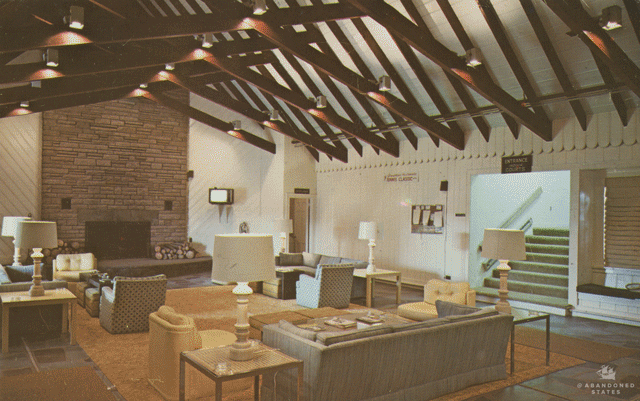
Grossinger’s indoor tennis center. The rear of the postcard is an ad for Grossinger’s rye bread, a local staple during the resort’s operation. Resort royalty Jenny Grossinger lays out the pitch: “The fun and fresh air people get here at Grossinger’s really gives them an appetite. They love all of our food – and a particular favorite is our Grossinger’s rye and pumpernickel bread. Now you can get this same healthy, flavorful bread at your local food store. Try a loaf. I’m sure you’ll love it.” (Photograph by Pablo Iglesias Maurer, postcard published by FPC advertising)
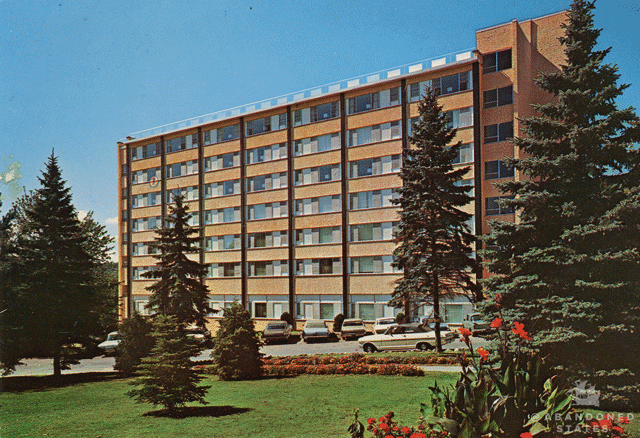
The Mies van der Rohe-inspired “Jenny G Wing” opened in 1964 and was among the last structures erected at Grossinger’s. It was designed by famed architect Morris Lapidus—the man who near single-handedly created the “Miami Modern” look in hotels and, more locally, designed the Capitol Skyline Hotel. (Photograph by Pablo Iglesias Maurer, postcard published by Bill Bard and Associates)

Sunbathing and swimming in the Poconos. Postmarked, 1967. “Dear Jonnie: If you were only here, I would take you out for a horse-back ride – or else we could go golfing. Be good until I see you. Dr. Waterman.” (Photograph by Pablo Iglesias Maurer, postcard published by Kardmaster Brochures.)
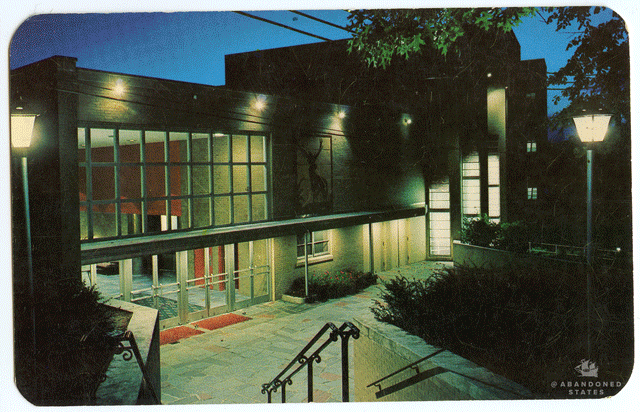
Stairs lead down to an abandoned theater in the Poconos. The curtain last fell here sometime in the early 90’s. (Photograph by Pablo Maurer, postcard published by Kardmasters)

The browns and reds and oranges of this Poconos dining hall’s carpet have turned green, the color of the moss that’s taken its place. Photo by (Pablo Iglesias Maurer, postcard published by Kardmasters)
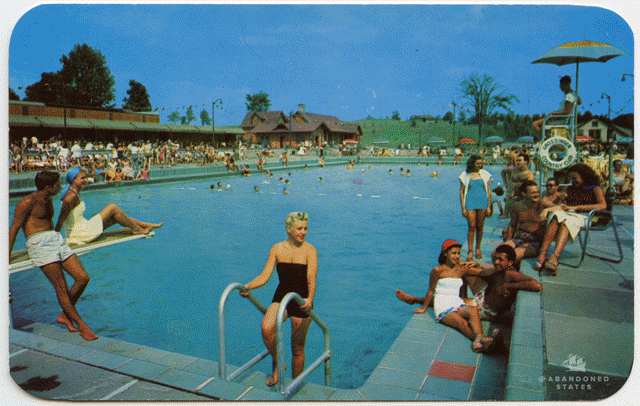
Grossinger’s outdoor pool, olympic sized, built in 1949 at a cost of $400,000 (about $5 million in today’s market.) Long gone are the private cabanas, changing room and lounges that used to surround it. (Photograph by Pablo Iglesias Maurer, postcard published by Bill Bard Associates)
Follow Pablo at Abandoned Estates.
Via DC-ist, Twitter, Ufunk, Bored Panda, BBC, Gizmodo
Would you like to support Flashbak?
Please consider making a donation to our site. We don't want to rely on ads to bring you the best of visual culture. You can also support us by signing up to our Mailing List. And you can also follow us on Facebook, Instagram and Twitter. For great art and culture delivered to your door, visit our shop.

